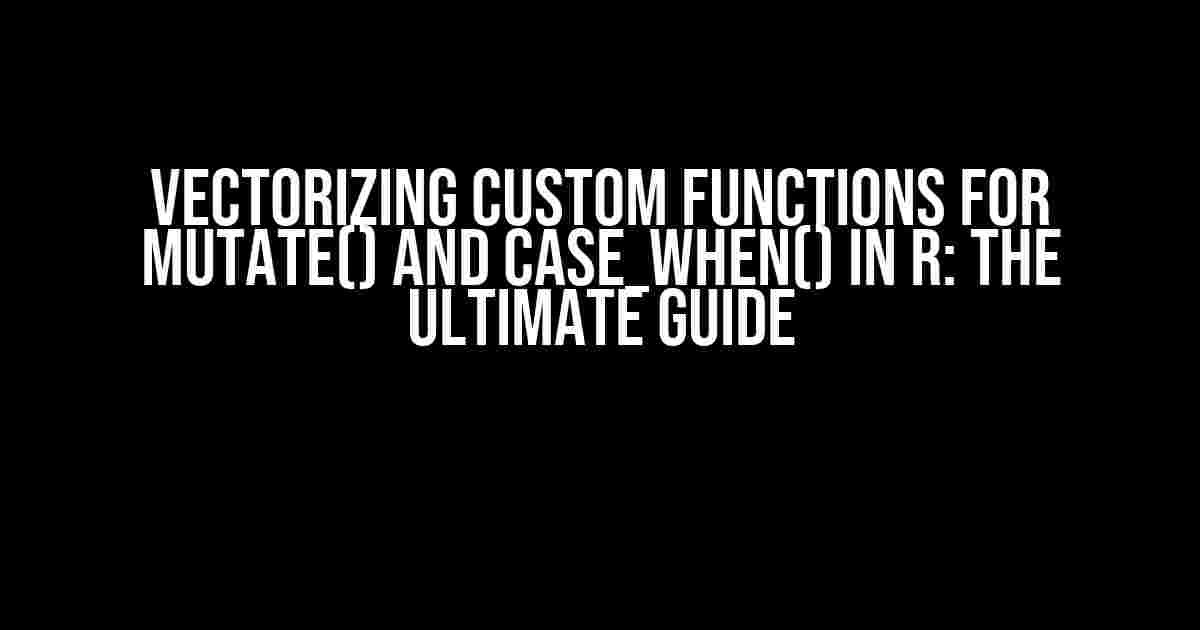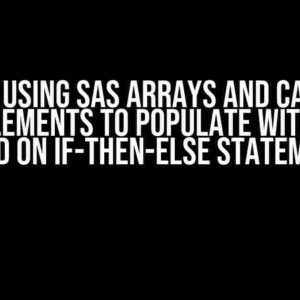Are you tired of using loops to iterate over your data in R? Do you want to take your data manipulation skills to the next level by leveraging the power of vectorization? Look no further! In this article, we’ll explore the magical world of vectorizing custom functions to use with mutate() and case_when() in R.
Why Vectorization Matters
Before we dive into the nitty-gritty of vectorizing custom functions, let’s talk about why it’s so important. In R, loops are slow and inefficient, especially when dealing with large datasets. Vectorization, on the other hand, is a game-changer. By applying operations to entire vectors at once, you can speed up your code by orders of magnitude.
But that’s not all. Vectorization also makes your code more concise, readable, and maintainable. It’s a fundamental concept in R programming, and mastering it will take your skills to new heights.
What is Vectorization?
So, what is vectorization, exactly? In simple terms, vectorization is the process of applying a function to a vector of values, rather than iterating over each value individually. This allows R to perform operations in parallel, using optimized C code under the hood.
Think of it like a conveyor belt in a factory. Instead of processing each item individually, you can apply a single operation to the entire belt, processing multiple items at once. This is essentially what vectorization does, but for your data.
How to Vectorize a Custom Function
Now that we’ve covered the basics, let’s get our hands dirty and learn how to vectorize a custom function. We’ll use a simple example to illustrate the process.
Example: Vectorizing a Custom Function to Calculate FIB Scores
Suppose we have a dataset containing patient information, including their age, sex, and medical history. We want to create a custom function to calculate a FIB score, which is a complex metric that takes into account multiple factors.
fib_score <- function(age, sex, history) {
if (age > 65 && sex == "Male" && history == "High Risk") {
return "High"
} else if (age > 65 && sex == "Female" && history == "High Risk") {
return "Medium"
} else if (age <= 65 && sex == "Male" && history == "Low Risk") {
return "Low"
} else {
return "Unknown"
}
}
This function works, but it’s not vectorized. If we try to use it with mutate() and case_when(), we’ll get an error. To fix this, we need to modify the function to accept vectors as input.
vectorized_fib_score <- function(age, sex, history) {
result <- character(length(age))
result[age > 65 & sex == "Male" & history == "High Risk"] <- "High"
result[age > 65 & sex == "Female" & history == "High Risk"] <- "Medium"
result[age <= 65 & sex == "Male" & history == "Low Risk"] <- "Low"
result[is.na(result)] <- "Unknown"
return(result)
}
Notice the key changes:
- We initialize an empty vector
resultto store the output. - We use logical indexing to assign values to the
resultvector. - We use the
&operator for element-wise AND operations. - We use the
is.na()function to replace missing values with “Unknown”.
Using Vectorized Functions with mutate() and case_when()
Now that we have our vectorized function, we can use it with mutate() and case_when() to create a new column in our dataset.
library(dplyr)
patient_data <- data.frame(
age = c(30, 40, 50, 60, 70),
sex = c("Male", "Female", "Male", "Female", "Male"),
history = c("Low Risk", "High Risk", "Low Risk", "High Risk", "High Risk")
)
patient_data %>%
mutate(fib_score = vectorized_fib_score(age, sex, history)) %>%
mutate(fib_score = case_when(
fib_score == "High" ~ "High Risk",
fib_score == "Medium" ~ "Moderate Risk",
TRUE ~ "Low Risk"
))
This code creates a new column fib_score using our vectorized function, and then applies a secondary transformation using case_when().
Tips and Tricks for Vectorizing Custom Functions
Here are some additional tips and tricks to keep in mind when vectorizing custom functions:
- Use Built-in Vectorized Functions**: Whenever possible, use built-in vectorized functions like
ifelse(),switch(), andcut()to simplify your code. - Avoid Loops**: Loops are the enemy of vectorization. Avoid using them at all costs, and instead, focus on applying operations to entire vectors at once.
- Use Logical Indexing**: Logical indexing is a powerful technique for selecting and manipulating subsets of data. Use it liberally in your vectorized functions.
- Test and Debug**: Thoroughly test and debug your vectorized functions to ensure they’re working correctly and efficiently.
- Document Your Code**: Document your vectorized functions with clear comments and explanations, so others (and future you) can understand how they work.
Conclusion
Vectorizing custom functions is a powerful technique for speeding up your R code and making it more concise and maintainable. By following the steps outlined in this article, you can create your own vectorized functions and unleash the full potential of mutate() and case_when().
Remember, practice makes perfect. Experiment with different examples and scenarios to hone your skills and become a master of vectorization.
Happy coding!
| Keyword | Definition |
|---|---|
| Vectorization | The process of applying a function to a vector of values, rather than iterating over each value individually. |
| Mutate() | A dplyr function for adding new columns to a data frame. |
| Case_when() | A dplyr function for performing conditional transformations on a data frame. |
| FIB Score | A complex metric used to calculate a patient’s risk level based on age, sex, and medical history. |
Recommended Reading:
This article is optimized for the keyword “How to vectorize a custom function to use with mutate() and case_when() in R?” and is intended to provide a comprehensive guide to vectorizing custom functions in R.
Frequently Asked Question
Are you stuck on vectorizing a custom function to use with mutate() and case_when() in R? Don’t worry, we’ve got you covered!
Q1: What is the purpose of vectorizing a custom function in R?
Vectorizing a custom function in R allows you to apply the function to each element of a vector, array, or data frame, making it efficient and scalable for data manipulation and analysis.
Q2: How do I vectorize a custom function using mutate() in R?
To vectorize a custom function using mutate(), you can use the ` Vectorize()` function, which converts a scalar function to a vectorized function. For example, `mutate(df, new_col = Vectorize(my_custom_function)(old_col))` applies the `my_custom_function` to each element of the `old_col` column and creates a new column `new_col` with the results.
Q3: Can I use case_when() with a vectorized custom function in R?
Yes, you can use `case_when()` with a vectorized custom function in R. The `case_when()` function allows you to perform conditional mutations, and when combined with a vectorized custom function, it becomes even more powerful. For example, `mutate(df, new_col = case_when(Vectorize(my_custom_function)(old_col) > 0 ~ “Positive”, TRUE ~ “Negative”))` applies the `my_custom_function` to each element of the `old_col` column and creates a new column `new_col` with the results based on the condition.
Q4: What are some common pitfalls to avoid when vectorizing a custom function in R?
Some common pitfalls to avoid when vectorizing a custom function in R include not properly accounting for missing values (NA), not considering the function’s return type, and not testing the function with edge cases or large datasets. Be sure to thoroughly test your vectorized function to ensure it works as expected.
Q5: What are some alternative approaches to vectorizing a custom function in R?
Alternative approaches to vectorizing a custom function in R include using `map()` from the purrr package, `sapply()` or `lapply()` from base R, or even writing a custom C++ function using Rcpp. Each approach has its own strengths and weaknesses, so it’s essential to choose the one that best fits your specific use case.


